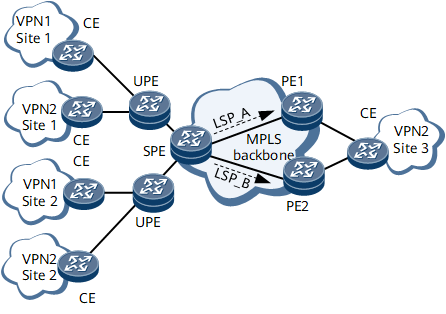Configuring VPNv4 FRR
In an H-VPN scenario in which VPNv4 FRR is configured, if the primary LSP between an ASBR or SPE and its next hop is unreachable, traffic quickly switches to the secondary LSP.
Usage Scenario
In an H-VPN scenario in which VPNv4 FRR is configured on an SPE, the SPE immediately switches VPN services to the standby link if the active link fails.

Pre-configuration Tasks
Before you configure VPNv4 FRR, complete the following tasks:
Configure a routing protocol on routers for them to communicate.
Configure two unequal-cost routes between the SPE and remote PE.
Procedure
- Run system-view
The system view is displayed.
- Run bgp as-number
The BGP view is displayed.
- Run ipv4-family vpnv4
The BGP-VPNv4 address family view is displayed.
- Run auto-frr
VPNv4 FRR is enabled.
- Run bestroute nexthop-resolved tunnel [ inherit-ip-cost ]
A VPNv4 route is configured to participate in route selection only when its next hop recurses to a tunnel. This configuration ensures that packets are not lost during traffic switchback.
- (Optional) Run route-select delay delay-value
A delay for selecting a route to the intermediate device on the primary path is configured. After the primary path recovers, an appropriate delay ensures that traffic switches back to the primary path after the intermediate device completes refreshing forwarding entries.
- Run commit
The configuration is committed.
Checking the Configurations
Run the display mpls lsp include ip-address mask-length verbose command to check the index and label of the backup LSP to which the VPNv4 route recurses.